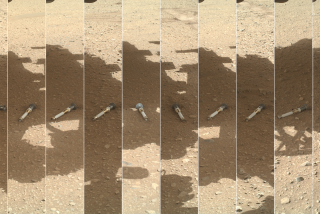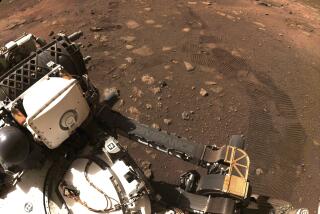Curiosity to scoop up Martian soil: First, it must rinse and spit
For the Mars Curiosity rover, it’s one “first-ever” after another.
The 1,982-pound explorer is now at a spot in Mars’ Gale Crater called Rocknest, ready to use its robotic scoop for soil samples. Scientists hope the samples will provide information crucial to the project’s central mission -- determining whether there were conditions on the planet at some time that could have fostered life.
That’s microbial life, to be exact, but still -- alien life. Four scoops of Martian dirt should be about right to provide new data to help solve this mystery.
PHOTOS: Latest images from Mars
“What makes Curiosity different from all other rovers is her ability to acquire samples of Mars soil and rock, and to analyze them in her onboard laboratories,” said Ashwin Vasavada in an interview Friday morning with the Los Angeles Times.
“This is an exciting week for us,” said the deputy project scientist for the Curiosity mission, “since we’re just days away from doing just those things for the first time.”
Rocknest, says NASA, is a patch of windblown sand and dust, about 8 feet by 16 feet, a great site for scooping because the rover will be able to dig several times.
The first two scoops that the rover collects are just for cleaning out any last remnants of the home planet that might be clinging to the scoop.
“We’ve found a nice, thick pile of typical Mars sand,” Vasavada said, “chosen because of its familiar properties and its ability to clean out the hardware. Even in our cleanest assembly buildings, it was not possible to keep minute amounts of oils and other chemicals off of Curiosity. The sand and some vigorous shaking should remove the last bits of Earth from the tools and get them ready to study Mars like we’ve never studied it before.”
According to NASA, the rover will scoop twice, shake the dirt “thoroughly ... to scrub the internal surfaces” and then dump the soil.
The fourth sample of soil from the scoop -- which isn’t that big, at 1.8 inches wide and 2.8 inches long -- will be analyzed by Curiosity’s instruments that identify chemical ingredients, NASA said.
“Our X-ray diffraction experiment shines X-rays through the sample’s rock crystals and can uniquely sense the fingerprint of each mineral,” Vasavada said. “Even this typical Mars sand will be seen in a new light, and could yield some surprises.”
Curiosity continues to send back photos and information to thrill the scientific community. Recently, the rover sent back images from an outcrop of rocks known as Link that showed evidence of an ancient riverbed on Mars.
After its work is done at Rocknest, Curiosity is to drive about 100 yards to the east into Glenelg for the first-ever use of its drill to burrow into a rock for even more samples.
ALSO:
1,500 plants seized at Chicago outdoor pot farm
Meningitis linked to steroid blamed for 5 dead, 30 sick
Don’t use Twitter to stage a hoax; N.J. teen could face charges
Join Amy on Google+. Email: [email protected]
More to Read
Sign up for Essential California
The most important California stories and recommendations in your inbox every morning.
You may occasionally receive promotional content from the Los Angeles Times.











